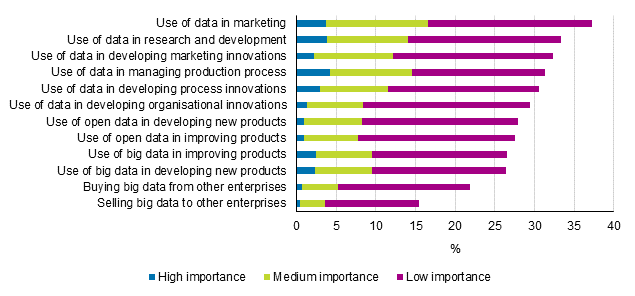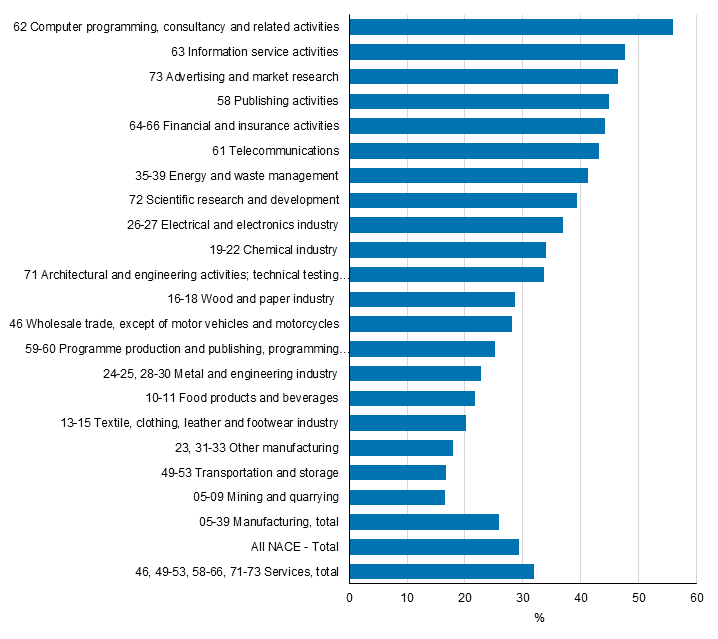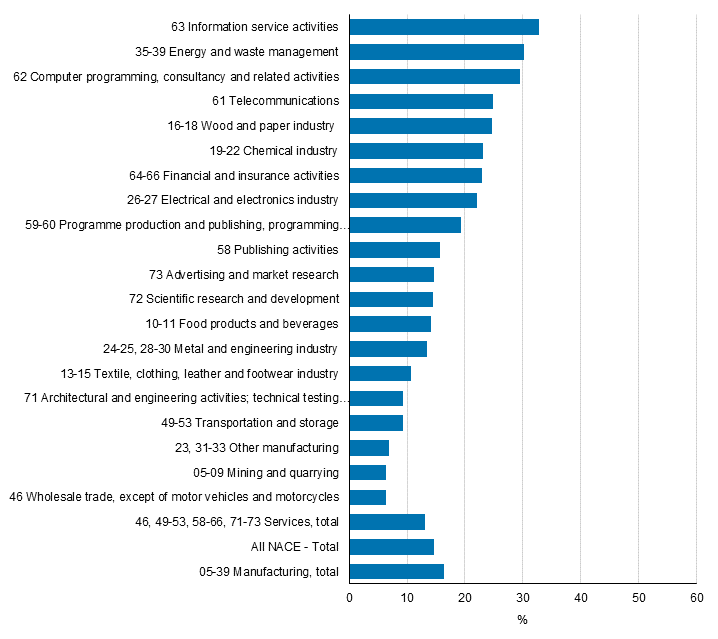6. Big data and open data in the public sector in enterprises’ business activity in 2012 to 2014
In the survey, public sector open data refer to data produced or accumulated by authorities in public administration that are publicly available and can be reused by anyone free of charge, legitimately and in machine readable format.
Here, big data or mass data refer to extremely large data sets that accumulate rapidly and that are in various formats. Devices and applications require huge storage capacity to be able to handle mass data. Big data are generated in electronic activities and machine-to-machine communications.
Of the mentioned uses, the most important for big data and public sector open data (high or moderate importance) were data use in R&D activities, data use in managing the production process and data use in marketing. Around 17 per cent of all enterprises estimated the importance of data as high or moderate in marketing and, for example, for around 15 per cent data were important in managing the production process. Data can also have a great importance for enterprises in developing process and market innovations. The selling or buying of big data was, however, important for fewer enterprises in terms of business activities.Figure 24. Importance of big data and public sector open data for enterprises’ business activity in 2012 to 2014, share of enterprises

One in ten of all enterprises estimated that at least one data use had had high importance for the enterprise and close on one-third of enterprises estimated that at least one data approach was of high or moderate importance. The importance of data seemed to grow as the size of the enterprise grew. Among small-sized enterprises, 11 per cent estimated the importance of data as high or moderate in R&D activities and 15 per cent reported open and big data as important in marketing. Among medium-sized enterprises the corresponding shares were 20 and 22 per cent and among largest enterprises, 36 and 31 per cent.
Even though big data and public sector open data can create valuable potential for business activity, a majority of the surveyed enterprises, however, estimated their importance as low or insignificant in the review period 2012 to 2014.
In many of the uses mentioned in the survey, the use of big data and public sector open data was somewhat more important in service industries than in manufacturing. The use of data in R&D activities was as important in both sectors and the use of data in managing the production process was mentioned slightly more often in manufacturing than in service industries.
Naturally, the use of open and big data varies by industry. For example, in the software industry more than one-half, 56 per cent, of enterprises estimated that at least one of the uses of data was significant, and around one-third felt the importance of data was high or moderate in product development, processes, marketing and R&D activities.Figure 25. Enterprises that found at least one of the use types related to big data and public sector open data to be of high or medium importance by industry in 2012to 2014, share of enterprises

Figure 26. Use of data in managing the production process with high or medium importance by industry in 2012 to 2014, share of enterprises

The use of big data and public sector open data was seen as more important in enterprises with innovation activity than in enterprises that had not reported innovation activity in 2012 to 2014. For example, the use of data in managing the production process was of high or moderate importance for around one-fifth and the use of data in marketing for some one-quarter of enterprises with innovation activity. For enterprises with no innovation activity, around six per cent thought the same. It should be noted that some enterprises who had not reported innovation activity did, however, respond that they used data in innovation development or other development activities. This can, for example, be phased development that was not seen as directly resulting in innovations.
Source: Innovation 2014, Statistics Finland
Inquiries: Mervi Niemi 029 551 3263, Heidi Pirkola 029 551 3246, tiede.teknologia@stat.fi
Director in charge: Mari Yl�-Jarkko
Updated 2.6.2016
Official Statistics of Finland (OSF):
Innovation [e-publication].
ISSN=1797-4399. 2014,
6. Big data and open data in the public sector in enterprises’ business activity in 2012 to 2014
. Helsinki: Statistics Finland [referred: 23.4.2024].
Access method: http://www.stat.fi/til/inn/2014/inn_2014_2016-06-02_kat_006_en.html

